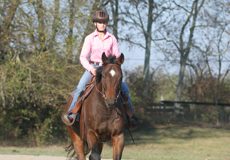Q: How do you train a horse to go from direct reining with two hands to neck reining with one hand?

Start with both hands on the reins, holding them in front of the pommel with one hand on each side of the horse’s neck. They should be fairly far apart, with about a foot of space between them. Imagine a straight line from your elbow to the corner of the horse’s mouth.
On trained horses, you’re probably accustomed to asking for a turn using a direct rein, where you pull back toward your hip in the direction you want to go. The direct rein is a “rein of opposition” and interferes with forward motion. You shouldn’t use a direct rein when you’re riding a young horse or you’ll stop him from moving freely forward. When you’re riding a young horse, you want him to learn to move ahead. You don’t want to train him to get “sticky feet” and stop too often, so forward motion is critical.
Instead, use a leading rein and open your inside hand in the direction you want to go. It helps the horse know to turn without stopping his forward motion. As a secondary rein aid, move your outside hand toward the horse’s neck, but never across the midline of the horse.
Steps to Neck Reining
When I’m starting a young colt, this is how I cue him to turn from the very first ride and progress step by step.
- Step 1: With the leading rein, I open the rein in the direction I want to go, and I reinforce this with what will be the neck rein (my outside hand). I lay the groundwork for the neck rein from the start so the horse begins to associate the feel of the rein on his neck with a turn.
- Step 2: I continue to practice turns by starting with the leading rein and adding the neck rein as the secondary cue. However, when he begins to turn, I release the leading rein (moving my hand back toward the midline of the horse) while keeping the neck rein in place. My goal is to hold the horse in the turn with the neck rein. At any time while I’m still holding the reins with two hands, I can reach down and bump with the leading rein (not pulling or holding pressure) to help him know to continue turning. That’s the second stage of training. After practicing this stage for a week or more, I’ll see if I can initiate the turn with the neck rein.
- Step 3: Next, I will try starting the turn with the neck rein. If the horse doesn’t turn, I’ll immediately bump with the leading rein to remind the horse of what I’m asking. I’ll continue asking him to turn with the neck rein first and then reinforce with a bump of the leading rein until he turns consistently off of the neck-rein cue.
- Step 4: Once you’re initiating and holding the turns as long as you want with the neck rein—and the horse is moving lightly off of the neck rein—you’re close to riding with one hand.

At this point, I continue to ride with two hands, but I move my hands closer and closer together. Soon, my knuckles are touching so that my hands are together as one. The horse feels what he will feel when I move to one hand, but I can quickly reinforce if needed.
I then move to a “trainer’s hold” on the reins—that’s where you have the reins crossing over the horse’s neck in a bridge, holding with one hand in the middle of the reins, palm down. Then I’ll switch to the standard split-rein hold later.
How Long Does it Take?
Depending on your horse’s age and experience, your level of skill and the amount of time you have to ride, this process can be taught in as little as three weeks or as long as several months.
A colt that has just started learning any cues will take a long time to learn the different rein aids. He needs to stay at the beginning levels for quite some time to make sure he has all the fundamentals.
If you are riding a trained horse that knows the leading rein well and just needs a reminder of the neck rein, you may be able to work through a step per week. If at any time you need to step back and remind the horse of the new cue, switch back to two hands.
This article originally appeared in the March 2016 issue of Horse Illustrated magazine. Click here to subscribe!






